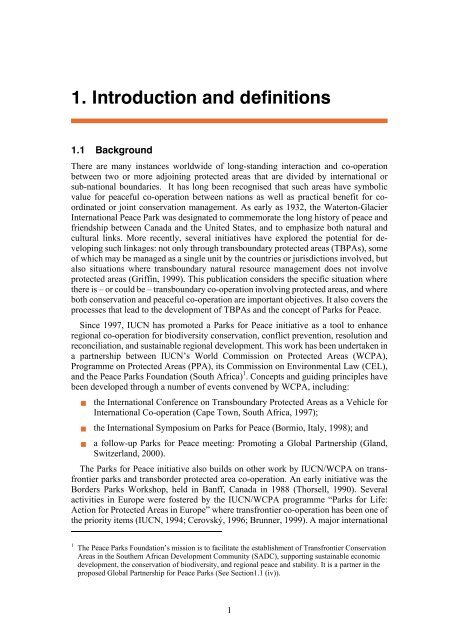Transboundary Protected Areas for Peace and Co-operation - IUCN
Transboundary Protected Areas for Peace and Co-operation - IUCN
Transboundary Protected Areas for Peace and Co-operation - IUCN
You also want an ePaper? Increase the reach of your titles
YUMPU automatically turns print PDFs into web optimized ePapers that Google loves.
1. Introduction <strong>and</strong> definitions<br />
1.1 Background<br />
There are many instances worldwide of long-st<strong>and</strong>ing interaction <strong>and</strong> co-<strong>operation</strong><br />
between two or more adjoining protected areas that are divided by international or<br />
sub-national boundaries. It has long been recognised that such areas have symbolic<br />
value <strong>for</strong> peaceful co-<strong>operation</strong> between nations as well as practical benefit <strong>for</strong> coordinated<br />
or joint conservation management. As early as 1932, the Waterton-Glacier<br />
International <strong>Peace</strong> Park was designated to commemorate the long history of peace <strong>and</strong><br />
friendship between Canada <strong>and</strong> the United States, <strong>and</strong> to emphasize both natural <strong>and</strong><br />
cultural links. More recently, several initiatives have explored the potential <strong>for</strong> developing<br />
such linkages: not only through transboundary protected areas (TBPAs), some<br />
of which may be managed as a single unit by the countries or jurisdictions involved, but<br />
also situations where transboundary natural resource management does not involve<br />
protected areas (Griffin, 1999). This publication considers the specific situation where<br />
there is – or could be – transboundary co-<strong>operation</strong> involving protected areas, <strong>and</strong> where<br />
both conservation <strong>and</strong> peaceful co-<strong>operation</strong> are important objectives. It also covers the<br />
processes that lead to the development of TBPAs <strong>and</strong> the concept of Parks <strong>for</strong> <strong>Peace</strong>.<br />
Since 1997, <strong>IUCN</strong> has promoted a Parks <strong>for</strong> <strong>Peace</strong> initiative as a tool to enhance<br />
regional co-<strong>operation</strong> <strong>for</strong> biodiversity conservation, conflict prevention, resolution <strong>and</strong><br />
reconciliation, <strong>and</strong> sustainable regional development. This work has been undertaken in<br />
a partnership between <strong>IUCN</strong>’s World <strong>Co</strong>mmission on <strong>Protected</strong> <strong>Areas</strong> (WCPA),<br />
Programme on <strong>Protected</strong> <strong>Areas</strong> (PPA), its <strong>Co</strong>mmission on Environmental Law (CEL),<br />
<strong>and</strong> the <strong>Peace</strong> Parks Foundation (South Africa) 1 . <strong>Co</strong>ncepts <strong>and</strong> guiding principles have<br />
been developed through a number of events convened by WCPA, including:<br />
<br />
<br />
the International <strong>Co</strong>nference on <strong>Transboundary</strong> <strong>Protected</strong> <strong>Areas</strong> as a Vehicle <strong>for</strong><br />
International <strong>Co</strong>-<strong>operation</strong> (Cape Town, South Africa, 1997);<br />
the International Symposium on Parks <strong>for</strong> <strong>Peace</strong> (Bormio, Italy, 1998); <strong>and</strong><br />
a follow-up Parks <strong>for</strong> <strong>Peace</strong> meeting: Promoting a Global Partnership (Gl<strong>and</strong>,<br />
Switzerl<strong>and</strong>, 2000).<br />
The Parks <strong>for</strong> <strong>Peace</strong> initiative also builds on other work by <strong>IUCN</strong>/WCPA on transfrontier<br />
parks <strong>and</strong> transborder protected area co-<strong>operation</strong>. An early initiative was the<br />
Borders Parks Workshop, held in Banff, Canada in 1988 (Thorsell, 1990). Several<br />
activities in Europe were fostered by the <strong>IUCN</strong>/WCPA programme “Parks <strong>for</strong> Life:<br />
Action <strong>for</strong> <strong>Protected</strong> <strong>Areas</strong> in Europe” where transfrontier co-<strong>operation</strong> has been one of<br />
the priority items (<strong>IUCN</strong>, 1994; Cerovský, 1996; Brunner, 1999). A major international<br />
1 The <strong>Peace</strong> Parks Foundation’s mission is to facilitate the establishment of Transfrontier <strong>Co</strong>nservation<br />
<strong>Areas</strong> in the Southern African Development <strong>Co</strong>mmunity (SADC), supporting sustainable economic<br />
development, the conservation of biodiversity, <strong>and</strong> regional peace <strong>and</strong> stability. It is a partner in the<br />
proposed Global Partnership <strong>for</strong> <strong>Peace</strong> Parks (See Section1.1 (iv)).<br />
1

















